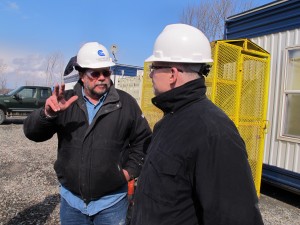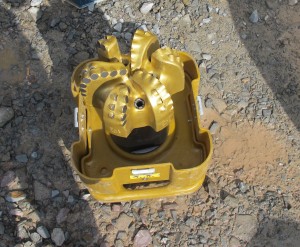Tootsie Pops and Diamonds in the Dog House
Drilling a hole in the ground 8,000 feet deep means you have to have a pretty tough knife to get through the rock. Not to mention turning that knife in solid rock to create a horizontal hole. Before any charges get put down a well to make holes in the casing, before any frack water gets pumped down a well to create enough pressure to release the gas, the well has to get drilled.
High up above the tree line, in a leveled clearing, a 136 foot tall rig sits pumping a drill bit through the earth. My tour guide on this Cabot drill rig in Susquehanna County is an Oklahoman named Steve McDonald. McDonald, like others on the rig, work 12 hours on, 12 hours off, two weeks on, two weeks off. He lives at the drill site, along with several other workers whose homes aren’t close enough to commute. Steve shows me the “doghouse,” a Battleship Galactica type room that towers 26 feet above the ground, and where I’m not allowed to snap photos. Here’s where the “Captain” sits. The drill Captain’s seat has two gear boxes attached on either side of his arm rests. There are lots of knobs that read things like “oscillation.”
His chair can swivel mechanically to allow him to watch what’s happening below ground from six different computer screens. There are digital color coded lines that measure things like torque. The entire doghouse shakes and vibrates and rumbles as the drill outside the window pumps up and down. I ask about how that stiff steel pipe turns to make a horizontal pathway thousands of feet below. McDonald hands me a cherry Tootsie Pop.

Susan Phillips / StateImpactPA
Steve McDonald, a contractor for Cabot Oil and Gas, speaks with a reporter at the drill site.
“It looks rigid,” says McDonald. “But anything can turn.” Just like the compressed paper that makes up the stem of a Tootsie Pop.
McDonald is even more excited to show me the drill bit. “It’s made of diamonds,” he says. Down the hatch again, he lifts up a hood to show a round solid, gold colored bit about one feet in diameter. The diamonds are manmade. Manmade? I ask. Polycrystalline diamonds that look round and flat like a nickel, not sharp and sparkling like the gem.
Nothing is harder than a diamond. But the natural diamonds that end up on fingers can splinter. So to get the cutting tool needed for drilling, fine diamond particles, or powder, are sintered together by heating them at about 1400 degrees Celsius. That makes them tougher. But these knives aren’t cheap. A drill bit can cost about $60,000 and require their own separate contract for transport.

















